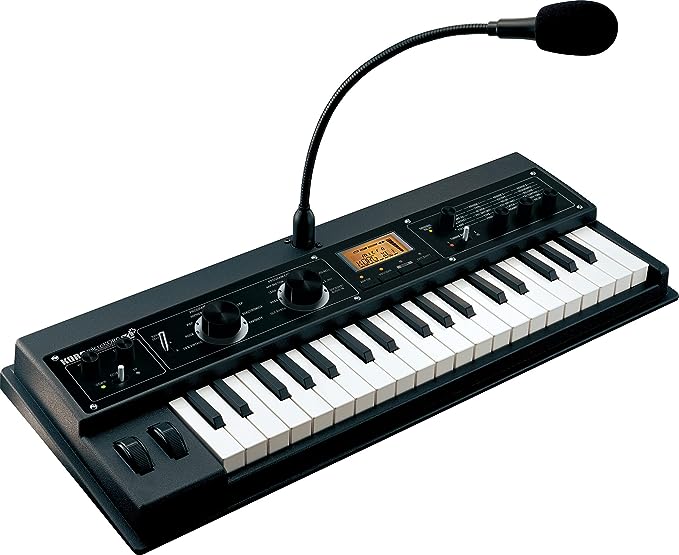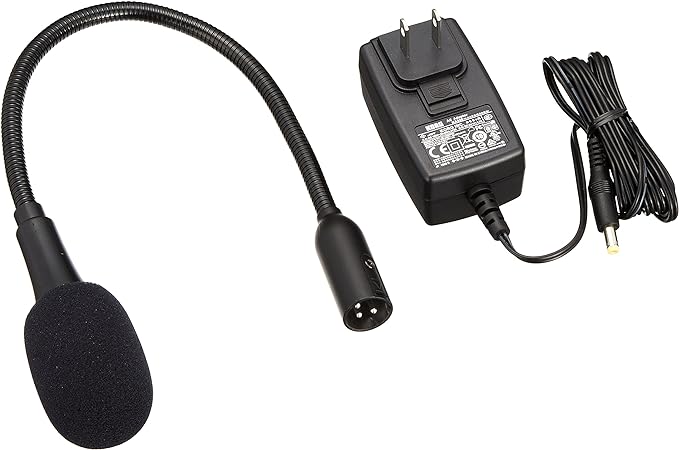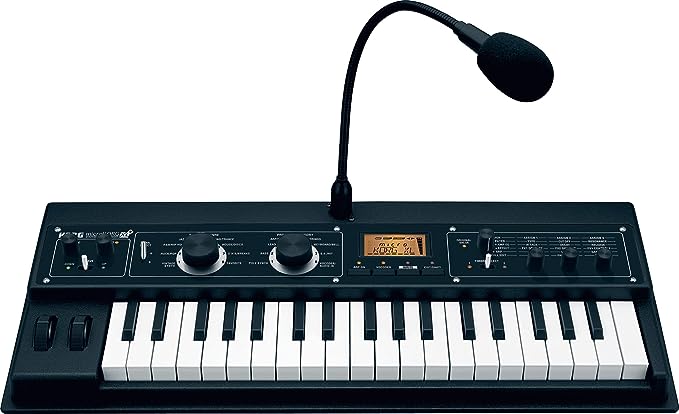MICROKORG OVERVIEW
Welcome to our in-depth MicroKorg Digital Piano Review! In this comprehensive analysis, we will explore the features, performance, and overall quality of the MicroKorg digital piano.
The MicroKorg has gained a well-deserved reputation as a versatile and compact instrument that combines the convenience of a digital piano with the power of a synthesizer. Whether you’re a professional musician, a hobbyist, or a beginner just starting your musical journey, the MicroKorg offers a wealth of possibilities to explore.
One of the standout features of the MicroKorg is its compact design, making it a perfect choice for musicians with limited space or those frequently on the go. Despite its small footprint, the MicroKorg packs an impressive array of features, allowing you to create a wide variety of sounds and textures.
Equipped with a powerful synthesis engine, the MicroKorg offers an extensive range of sound options. From classic vintage analog tones to modern digital textures, the MicroKorg delivers a rich and diverse sonic palette to inspire your creativity. Its intuitive interface and user-friendly controls make it easy to shape and manipulate sounds to suit your musical preferences. Join us as we embark on this comprehensive exploration of the MicroKorg digital piano. By the end of this review, you’ll have a clear understanding of its strengths, limitations, and its potential to inspire and enhance your musical journey. Let’s dive in and discover the wonders of the MicroKorg digital piano together!


MICROKORG FIRST IMPRESSIONS
Upon first encountering the MicroKorg, one cannot help but be captivated by its sleek and compact design. Its modern aesthetic, coupled with its portability, instantly appeals to musicians seeking a versatile instrument that can be easily incorporated into any setup.
The moment one engages with the MicroKorg, its intuitive interface and user-friendly controls make a positive impression. Navigating through the various functions and settings feels natural, even for those new to synthesizers. The well-laid-out knobs, buttons, and display contribute to an effortless and enjoyable user experience.
Turning the MicroKorg on reveals its true power. The range of sounds that emanate from this diminutive instrument is truly remarkable. From lush pads and ethereal atmospheres to biting leads and gritty basslines, the MicroKorg proves itself as a capable and inspiring sound generator. The synthesis engine delivers an impressive level of detail and nuance, allowing for precise sculpting and shaping of sounds.
Exploring the different presets and patches, it becomes clear that the MicroKorg offers a treasure trove of sonic possibilities. From classic analog emulations to modern digital textures, the MicroKorg covers an extensive sonic landscape that can suit a wide range of musical genres and styles.
The built-in effects and arpeggiator further enhance the MicroKorg’s sonic potential, adding depth, movement, and rhythmic complexity to the soundscape. These features open up endless creative avenues, whether you’re performing live, recording in the studio, or simply experimenting with new musical ideas.
Features
The MicroKorg is packed with a multitude of features that contribute to its versatility and musical prowess. Firstly, it boasts a robust sound engine that offers a vast array of high-quality sounds, ranging from classic analog emulations to cutting-edge digital textures. The extensive sound library covers a wide range of instruments, including pianos, strings, brass, synthesizers, and more, allowing for seamless exploration of various musical genres.
It is adorned with an array of knobs, buttons, and a clear display, providing effortless control and navigation. This user-friendly design ensures quick access to essential parameters, enabling musicians to shape their sounds on the fly. Additionally, the inclusion of a vocoder adds an exciting vocal manipulation capability, allowing users to create unique and expressive vocal effects.
Programs
The MicroKorg offers a wide range of programs that showcase its diverse capabilities and sonic versatility. Its program selection includes various categories such as keyboard, organ, synth, bass, lead, brass, strings, pad, and more. Each category contains a collection of meticulously crafted sounds that cover a vast musical spectrum.
Within the keyboard category, you’ll find rich and expressive piano, electric piano, and clavinet sounds that faithfully reproduce the nuances of their acoustic counterparts. The organ category delivers a selection of classic organ tones, ranging from smooth and mellow to vibrant and punchy. For synth enthusiasts, the synth category offers an abundance of textures, from classic analog-style leads and evolving pads to futuristic and experimental sounds. The bass category provides a wide array of deep and punchy bass tones, perfect for laying down a solid foundation in various musical genres.
Beyond these categories, the MicroKorg also offers a variety of other programs, including sound effects, percussion, vocals, and more. This extensive program selection ensures that you have an extensive palette of sounds to explore and experiment with, allowing you to create music that matches your unique artistic vision.
8-Band Vocoder
The MicroKorg features an impressive 8-Band Vocoder, which adds a unique and expressive dimension to your sound palette. With the 8-Band Vocoder, you can create robotic, vocoded, and synthesized vocal effects, allowing you to add a distinctive touch to your music.
The vocoder works by combining the input signal, usually a microphone or external audio source, with the internal synthesizer engine of the MicroKorg. The vocoder then analyzes the spectral content of the input signal and applies it to the synthesizer’s sound, resulting in a fusion of the original signal and synthesized tones.
It offers precise control over the vocal effect with its eight frequency bands. This allows you to shape the tonal characteristics of the vocoded sound, emphasizing certain frequencies or creating unique vocal textures. You can experiment with different settings and adjust the balance between the input signal and the synthesized sound to achieve the desired effect. With its intuitive controls and powerful capabilities, the 8-Band Vocoder of the MicroKorg enables you to explore new sonic territories and unleash your creativity. Whether you’re a vocalist, producer, or electronic musician, this feature adds a distinctive flavor to your sound palette, making the MicroKorg a truly remarkable instrument for expressive and imaginative musical endeavors.
Effects
The MicroKorg offers a comprehensive effects section that adds depth, texture, and character to your sounds. The delay effect creates echoes, adding a sense of space and rhythmic interest. With adjustable parameters such as delay time and feedback, you can create anything from subtle repeats to complex rhythmic patterns. The reverb effect simulates different acoustic environments, from small rooms to large halls, providing a natural and immersive ambience. This effect is ideal for adding depth and dimension to your sounds, making them feel more spacious and atmospheric.
The chorus effect enriches your sounds by creating multiple voices that blend together, resulting in a thick and lush texture. It adds a shimmering quality and widens the stereo image, making your sounds more vibrant and expansive. The flanger effect introduces a sweeping and swirling motion to your sounds, creating a unique and dynamic character. It is particularly effective for adding movement and interest to synthesizer sounds and guitar solos.
With the MicroKorg’s versatile effects section, you have a range of tools at your disposal to enhance and transform your sounds. From creating lush and atmospheric textures with reverb and chorus, to adding rhythmic interest with delay and flanger, these effects allow you to unleash your creativity and explore new sonic possibilities. Whether you’re performing live, recording in the studio, or experimenting with sound design, the MicroKorg’s effects offer a powerful means of shaping and sculpting your musical creations.
MICROKORG SPECS
- 37 velocity-sensitive mini keys
- Analog modeling synthesizer
- 4 voices
- 128 programs (including 8 user programs)
- AC adapter or battery operation (6 AA batteries)
- The dimensions of the MicroKorg are 524 millimeters in width, 232 millimeters in depth, and 70 millimeters in height.
- 2.2 kg (excluding batteries)
- 2 oscillators with multiple waveforms (sawtooth, square, triangle, and more)
- 1 resonant low-pass filter per voice, with adjustable cutoff, resonance, and envelope settings
- 2 envelope generators and 2 LFOs (Low-Frequency Oscillators) for flexible modulation possibilities
- Integrated effects section with delay, reverb, chorus, flanger, and EQ
- Built-in arpeggiator with multiple patterns and adjustable parameters
- 8-band vocoder for vocal effects and synthesis
- Intuitive control panel with knobs, buttons, and a clear display for easy parameter adjustment
- MIDI in/out ports for connecting external devices, audio input for processing external audio sources, headphone output, and audio output jacks

CONCLUSION
In conclusion, the MicroKorg stands as a remarkable instrument that combines portability, versatility, and expressive capabilities. With its compact design and lightweight construction, it is a go-to choice for musicians on the move, whether performing on stage or creating music on the go.
The MicroKorg’s sound engine, based on analog modeling synthesis, delivers a rich and diverse palette of sounds. From classic analog-style leads to lush pads, punchy basses, and vibrant brass, its vast program selection offers an extensive range of sonic possibilities. The inclusion of a vocoder adds a unique dimension to vocal processing, allowing for robotic, vocoded, and synthesized vocal effects that can truly captivate listeners. The effects section of the MicroKorg further enhances the sonic capabilities, providing options to shape and transform sounds with delay, reverb, chorus, flanger, and EQ. These effects open up a world of creative possibilities, allowing musicians to add depth, movement, and texture to their music.

